Pricing your handmade wood items right is key to making more money. Many woodworkers find it hard to set the perfect price. This often leads to them not getting enough for their work.
Knowing your costs, valuing your time, and using important formulas are essential. These steps help you find the best price for your items. With good pricing strategies, your woodwork can be more profitable.
Find out how to use a pricing formula that fits your needs. Learn to balance material costs, labor, and market demand. This way, you can make your wood projects more profitable.
The Challenge of Pricing Handmade Wood Projects
Woodworkers face a big challenge when pricing their handmade wood projects. It’s not just about covering costs. It’s also about showing the value these unique items have for customers.
Setting the right price for handmade wood projects is a fine balance. It must cover costs like materials and labor. It also needs to leave room for profit, showing the value of the work done. Woodworkers must think about material costs, time spent making the item, and extra costs like marketing.
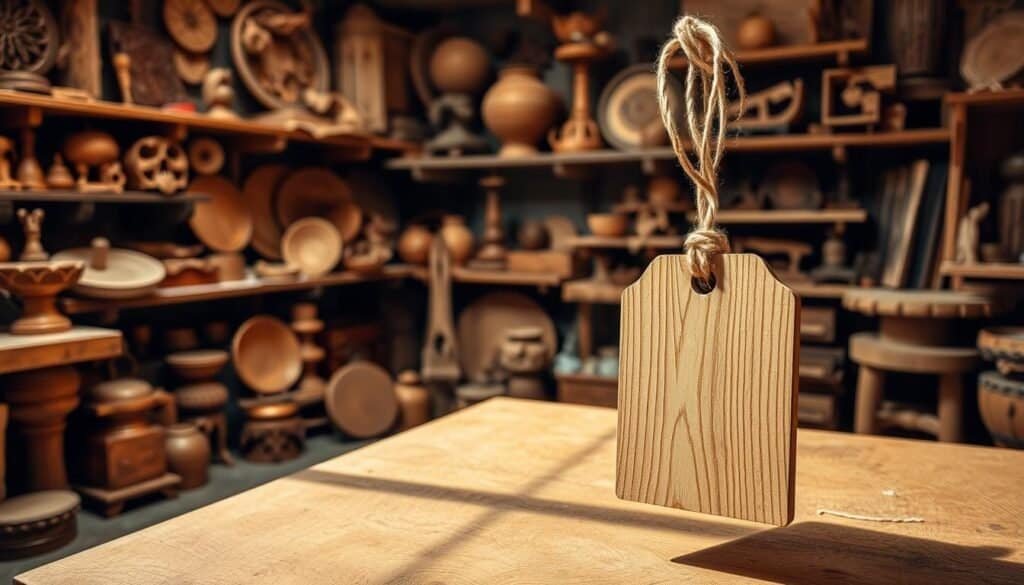
Knowing your target market is key. Woodworkers should research their competition and customers. They need to find out what price people are willing to pay for similar items.
It’s not just about being competitive. It’s about showing the special value of handmade items. By focusing on quality, craftsmanship, and uniqueness, woodworkers can charge more. This attracts customers who are willing to pay for premium handmade wood projects.
Effective pricing strategies for woodworkers combine understanding costs, knowing the market, and using smart pricing tips. By mastering these, woodworkers can overcome pricing challenges. They can build a successful business.
Understanding Your True Costs
Knowing the real costs of your woodworking projects is key to a good pricing strategy. To set the right price for your handmade wood items, you must think about all the costs involved.
Materials are a big part of the cost. This includes the wood, finishes, and any hardware or accessories. Keeping track of what you use for each project helps you figure out this cost. For simple projects, you might use common lumber and basic hardware. But for more complex items, you might need special woods or custom hardware.

Labor costs are also important. This includes the time spent on the project, planning, designing, and preparing materials. As a woodworker, your skills and time are worth something. Your pricing should show this value. A pricing guide can help you figure out how to price your labor right.
Don’t forget about overheads. These are costs like workshop rent, equipment upkeep, and marketing. Knowing your overheads helps you make sure your pricing covers all your expenses and gives you a profit.
To get a clear picture of your costs, keep detailed records. This means saving receipts for materials, tracking time spent on projects, and recording overheads. With a clear view of your costs, you can use pricing strategies to set prices that are both fair and profitable.
Understanding your true costs helps you make smart pricing decisions. Whether you’re making simple wood projects or more complex ones, knowing your costs lets you price them right. This shows their value to your customers.
Valuing Your Time and Expertise
Pricing your handmade wood items needs you to understand your time and skill’s worth. As a woodworker, your skills greatly affect your product’s price. It’s not just about materials; your time and skill are valuable too.
To value your time right, start by tracking how much time each project takes. This includes prep, execution, and extra tasks like finishing. Knowing the total time helps you figure out your labor cost per hour.
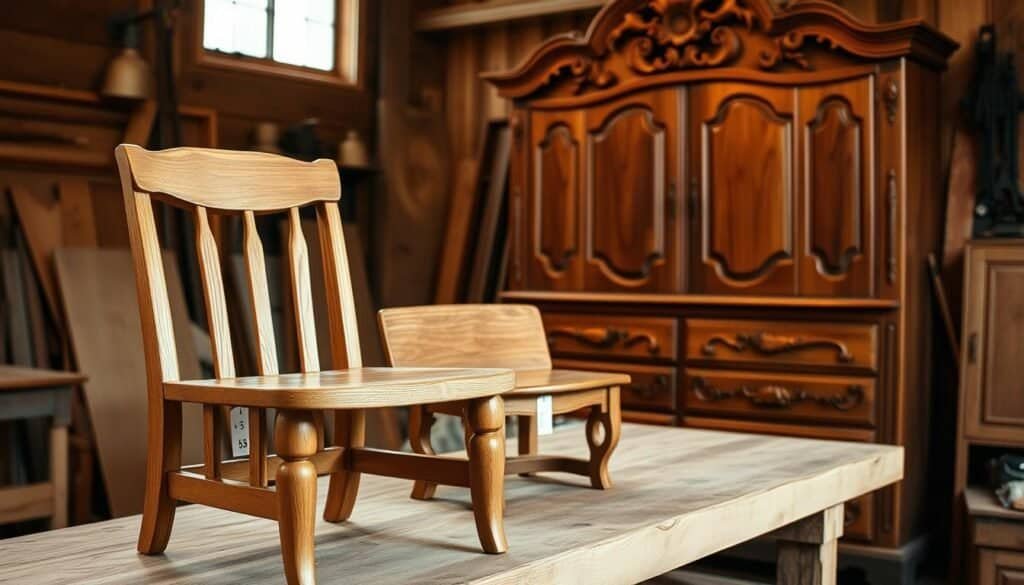
When setting your hourly rate, think about your skill level, project complexity, and demand. For example, a custom piece of furniture might cost more than a mass-produced one. To make more money, balance your costs with what customers are willing to pay.
A simple pricing formula for woodworking projects is: Materials Cost + (Hourly Labor Rate * Number of Hours) = Total Cost. Then, add your profit margin to get the final price.
Valuing your time and skill correctly makes your pricing fair, competitive, and profitable. This helps keep your business growing by investing profits in better materials, tools, or marketing.
How to Price Your Wood Projects for Profit: Essential Formulas
To make a profit, woodworkers must know how to price their work. Pricing right is key for your woodworking business to succeed. It’s not just about covering costs; it’s about earning a fair income for your skills.
First, figure out your costs. This includes materials, tools, and your time. A basic formula is: Cost = Materials + Labor + Overhead. For DIY woodworkers, figuring out labor costs can be hard but it’s vital for making money.
Market Research Techniques
Knowing your market is essential. Find out what similar woodworking projects sell for. Check online, local fairs, and competitors’ sites. This helps set your prices.

When researching, think about your product’s uniqueness, materials, and time. These can justify higher prices if your items offer more value than others.
Positioning Your Products
Decide how you want to position your wood projects in the market. Do you want to compete with mass-produced items or offer unique, handmade pieces? If your items are special or of high quality, you can charge more. Emphasize the craftsmanship and personal touch in your pricing.
To stay profitable, use the pricing formulas well. For example, if a project costs $100 and you want a 50% markup, sell it for $150. This simple formula helps keep your business profitable.
In summary, pricing your wood projects for profit means understanding costs, doing market research, and positioning your products right. By using these formulas and tips, your woodworking business can thrive and stay profitable.
Setting Different Profit Margins for Different Products
Woodworkers should set different profit margins for their products. Not all wood projects are the same. Their prices should match their unique features, like how long they take to make and how much they cost.
It’s key to sort your wood products by how complex they are and how much value they offer. For example, simple projects like birdhouses made from scrap wood might cost less to make. But, detailed items like wooden sculptures need more skill and time, so they can cost more.
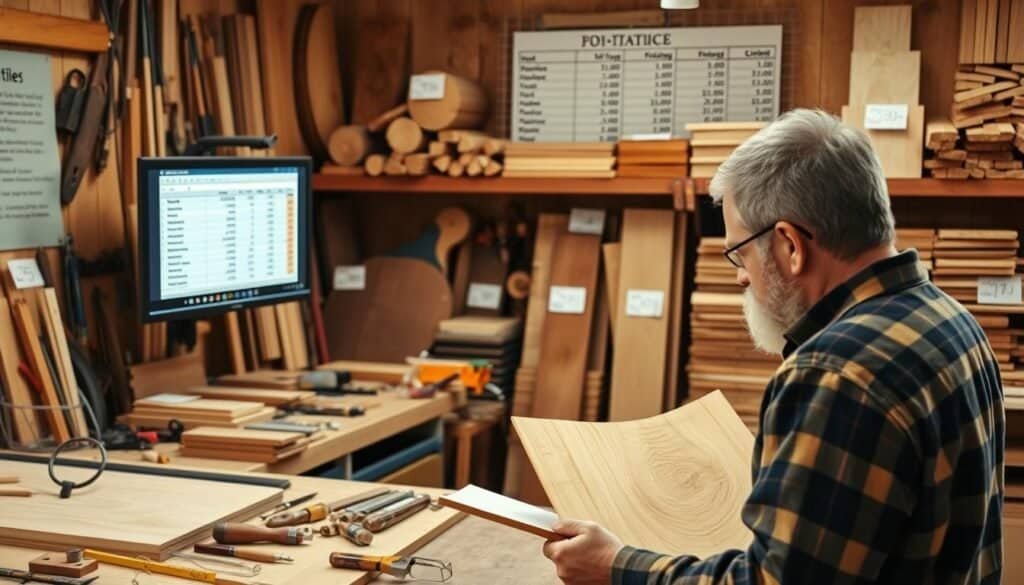
Also, think about who you’re selling to. If you’re selling to people who want unique, handmade items, you can charge more. But, if you’re in a busy market with lots of similar items, you might need to price lower to stay competitive.
Where you sell your products also matters. For instance, selling online might mean you make less money because of fees. But, selling directly to customers on your website or at local fairs can help you keep more of the profit.
By looking at these factors and setting the right profit margins, your woodworking business can stay profitable. This smart pricing strategy will help you make more money while also giving your customers great value.
The Psychology of Pricing Handcrafted Wood Items
When selling handmade wood products, the price matters a lot. It’s not just about making money. It’s also about how it makes customers feel.
How you price your items shows their value and quality. A higher price can mean they’re special or of high quality. But, very low prices might make people think they’re not worth it.
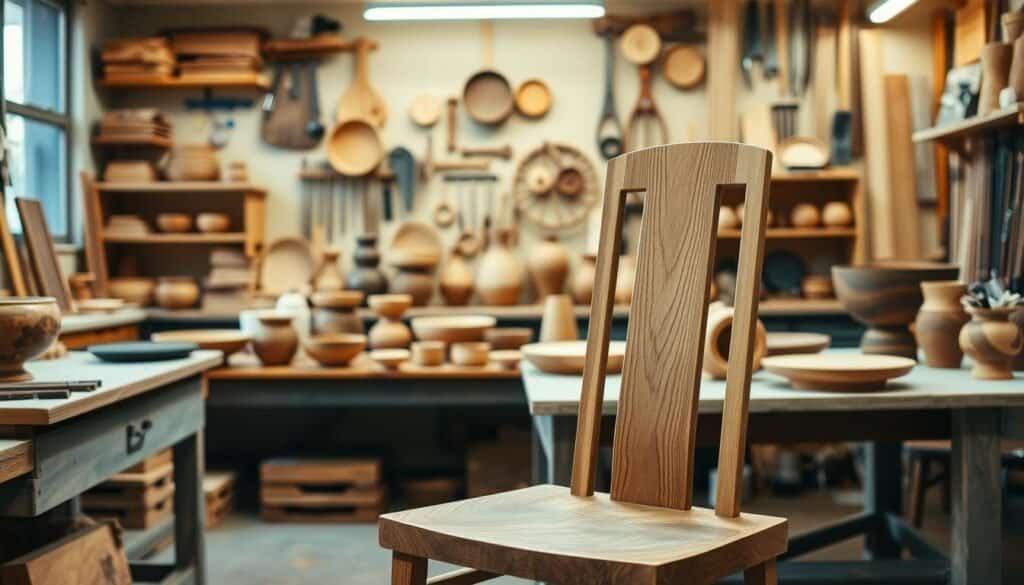
Knowing how pricing works can help you make more money. For example, using a formula that includes material costs, time, and skill can set good prices. This way, you can be competitive and profitable.
Another trick is charm pricing or anchoring. Charm pricing is setting prices just below a round number, like $99 instead of $100. Anchoring is showing a higher “original” price next to a lower “sale” price. This makes the sale price look better.
For reclaimed wood, the story behind it can affect the price. Talking about its history or eco-friendliness can make it worth more. This appeals to those who care about the environment and uniqueness.
In the end, knowing your customers and what they’re willing to pay is key. By using a pricing formula and psychological tricks, you can set prices that work for your business and please your customers.
Pricing Strategies for Different Sales Channels
Maximizing profits starts with understanding how to price your handmade wood items. You need to adjust your prices for each sales channel. This includes online, craft fairs, and brick-and-mortar stores.
Selling online on platforms like Etsy or eBay means watching the competition and fees. Etsy sellers face listing, transaction, and payment processing fees. To stay competitive, you might need to lower your prices. Also, think about free shipping or discounts for bulk orders to draw in more buyers.

Craft fairs offer a different pricing approach. You can talk directly to customers and adjust prices on the spot. Remember to factor in booth rental, travel, and setup time costs.
Brick-and-mortar stores require a different pricing strategy. Prices are influenced by the store’s audience, location, and competition. You might need to negotiate with the store owner. Make sure your prices allow for a good profit margin after the store’s commission.
Adjusting your pricing for each sales channel can boost your sales and profits. Keep an eye on your pricing and make changes as needed. This helps you stay competitive and grow your woodworking business.
Communicating Value to Justify Your Prices
Telling customers the value of your handmade wood projects is essential. When they see the effort, skill, and quality, they’re more likely to accept the price.
To share value, start by pointing out what makes your items special. This could be the wood type, the craftsmanship, or custom details that make them unique.
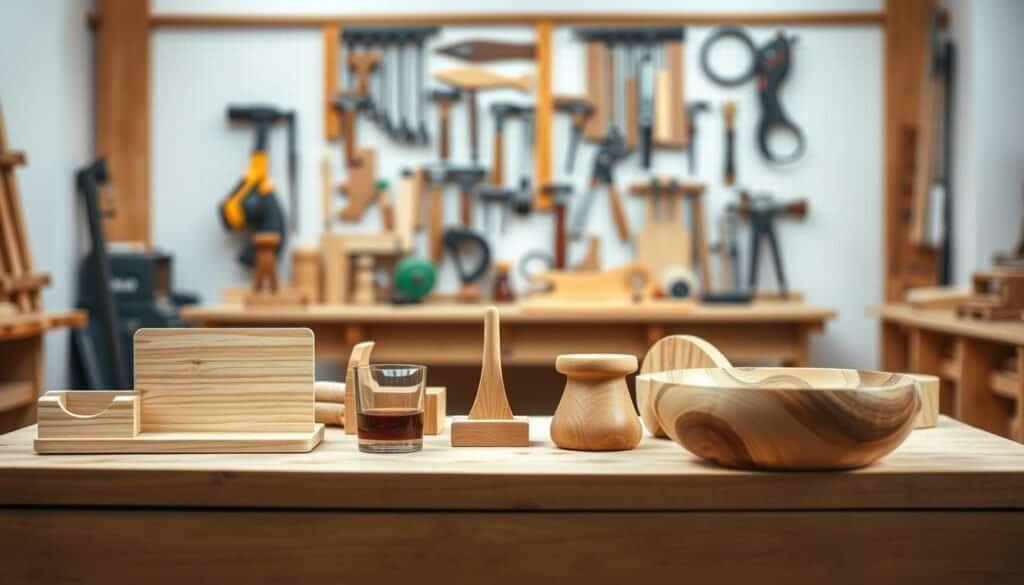
Also, share the story behind your woodworking. People love the personal touch in handmade items. Talk about your design process, what inspired you, and the care you put into each piece.
Being open about your pricing is also important. Consider showing how you calculate your costs, like materials, time, and other expenses. This honesty can build trust and make customers more comfortable with your prices.
By focusing on the value of your handmade wood projects, you can justify your prices. This attracts customers who value quality craftsmanship.
Common Pricing Mistakes Woodworkers Make
Many woodworkers make big pricing mistakes. Knowing how to price handmade wood items right is key for a woodworking business to succeed. Wrong pricing can cut profits or even lead to losses.
One big mistake is forgetting to include all costs. Woodworkers often overlook things like workshop rent, equipment costs, and marketing when setting prices. Keeping a detailed record of all expenses is a must.
Another error is not valuing time and skill enough. Woodworkers might spend hours on a piece but not charge enough for it. They might earn less than minimum wage. It’s important to figure out the hourly rate and include it in the final price.

Setting prices too low to attract customers is also a mistake. Starting with low prices might seem appealing, but it can make the product seem cheap. Woodworkers should focus on showing the value of their handmade items.
On the other hand, pricing too high can scare off buyers. Finding the right balance is key. Woodworkers should research the market to see what customers are willing to pay for similar items.
Lastly, not updating prices when costs change is a big mistake. As material or other expenses go up or down, prices should adjust to keep profits up.
By avoiding these common pricing mistakes, woodworkers can keep their business profitable and growing. Using smart pricing strategies is essential for success in this competitive market. Whether it’s small wooden projects or bigger items, getting the price right is critical.
Pricing Specific Types of Wood Projects
Different woodworking projects need their own pricing plans. It’s key to know what makes each project unique. This helps figure out how much to charge.
For example, small wood projects like coasters or picture frames are simpler. They need less material than big furniture. The cost of materials, time, and customer value should be considered when pricing them. On the other hand, barn wood projects use reclaimed wood. This can be pricier to get and prepare.
Wood decor items, like wall art or candle holders, have varying prices. This depends on their design, size, and wood type. A basic wooden candle holder might cost less than a detailed wooden wall art piece.
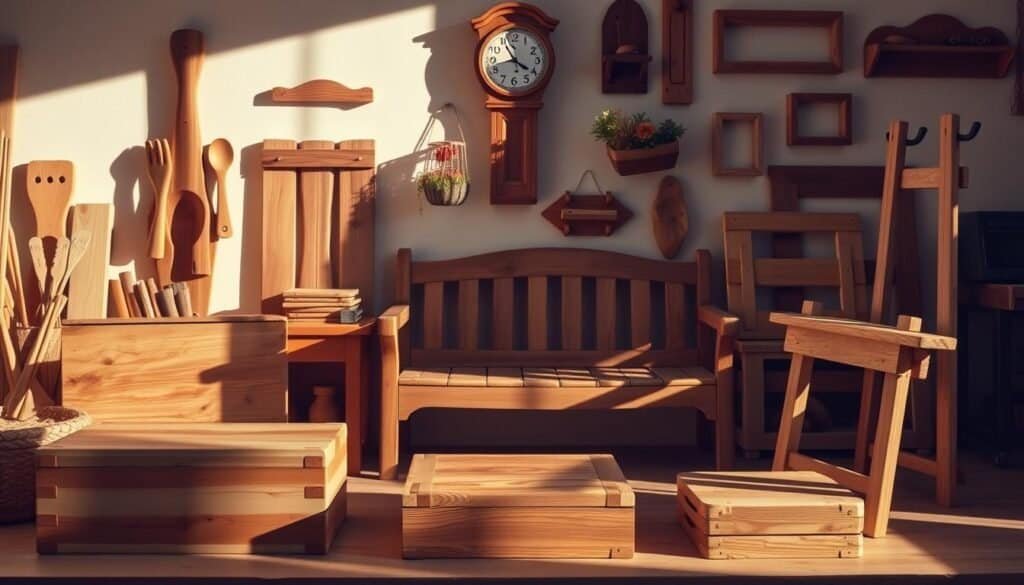
When pricing furniture, think about the wood type, complexity, and function. A handmade wooden chair, for example, takes more time and skill than a simple cutting board. The price should show these differences.
To price your projects right, know your costs, the value you offer, and the best pricing strategies. This way, your business can stay competitive and profitable.
When and How to Raise Your Prices
Knowing when to increase prices is key for a woodworking business to stay profitable. As your business grows, so do your costs. It’s important to adjust your pricing to keep profits high.
Raising prices can be tough, but sometimes it’s needed. You might need to raise prices if more people want your products, if material costs go up, or if you start making more complex projects. A good pricing guide should consider these factors.

When you decide to raise prices, think about how it will affect your customers. It’s important to tell them why prices are going up. This could be because of better quality, more features, or using top-notch materials in your wood projects.
Communicating Price Changes
It’s vital to explain price changes well to your customers. Tell them why prices are going up and what they’ll get in return. This could be better product quality, faster service, or improved customer support.
By raising prices wisely and explaining the value to your customers, you can keep your business profitable. You’ll also keep delivering top-quality wood projects that meet your customers’ needs and expectations.
Testing and Refining Your Pricing Strategy
Creating a good pricing strategy is an ongoing task. It’s not just about setting prices once and forgetting about it. You need to keep checking and tweaking your pricing for woodworking projects to make more money.
Start by watching what customers say and looking at your sales data. This helps you spot trends and patterns. If you’re making a lot of profit on some items, you might be able to raise prices a bit more. But, if some items aren’t selling, you might need to lower prices or find a different group of customers.

Improving your pricing also means watching what your competitors do. Keep an eye on their prices and adjust yours to stay ahead. Also, think about running sales or discounts to boost sales and get rid of leftover wood projects.
By always testing and improving your pricing, you can keep your woodworking business profitable and competitive.
Conclusion: Building a Sustainable and Profitable Woodworking Business
Setting the right price for your handmade wood items is key to a successful woodworking business. You need to know your costs, value your time, and use formulas to price projects right. This way, you can attract customers and increase sales.
Think about how pricing affects your wood items. Adjust your prices for different sales channels. Showing the value of your small wood projects can justify your prices and keep customers coming back.
Keep testing and improving your pricing strategy. This will help you stay ahead in the market. By following these tips and staying focused on your goals, you can build a profitable woodworking business that brings you success for years to come.
